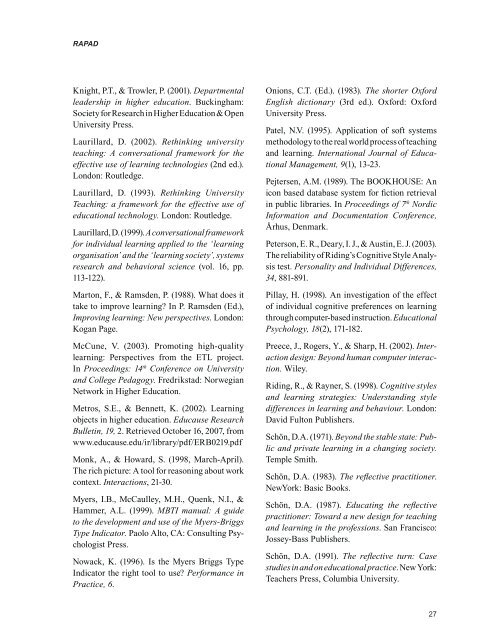Advances in E-learning-Experiences and Methodologies
You also want an ePaper? Increase the reach of your titles
YUMPU automatically turns print PDFs into web optimized ePapers that Google loves.
RAPAD<br />
Knight, P.T., & Trowler, P. (2001). Departmental<br />
leadership <strong>in</strong> higher education. Buck<strong>in</strong>gham:<br />
Society for Research <strong>in</strong> Higher Education & Open<br />
University Press.<br />
Laurillard, D. (2002). Reth<strong>in</strong>k<strong>in</strong>g university<br />
teach<strong>in</strong>g: A conversational framework for the<br />
effective use of learn<strong>in</strong>g technologies (2nd ed.).<br />
London: Routledge.<br />
Laurillard, D. (1993). Reth<strong>in</strong>k<strong>in</strong>g University<br />
Teach<strong>in</strong>g: a framework for the effective use of<br />
educational technology. London: Routledge.<br />
Laurillard, D. (1999). A conversational framework<br />
for <strong>in</strong>dividual learn<strong>in</strong>g applied to the ‘learn<strong>in</strong>g<br />
organisation’ <strong>and</strong> the ‘learn<strong>in</strong>g society’, systems<br />
research <strong>and</strong> behavioral science (vol. 16, pp.<br />
113-122).<br />
Marton, F., & Ramsden, P. (1988). What does it<br />
take to improve learn<strong>in</strong>g? In P. Ramsden (Ed.),<br />
Improv<strong>in</strong>g learn<strong>in</strong>g: New perspectives. London:<br />
Kogan Page.<br />
McCune, V. (2003). Promot<strong>in</strong>g high-quality<br />
learn<strong>in</strong>g: Perspectives from the ETL project.<br />
In Proceed<strong>in</strong>gs: 14 th Conference on University<br />
<strong>and</strong> College Pedagogy. Fredrikstad: Norwegian<br />
Network <strong>in</strong> Higher Education.<br />
Metros, S.E., & Bennett, K. (2002). Learn<strong>in</strong>g<br />
objects <strong>in</strong> higher education. Educause Research<br />
Bullet<strong>in</strong>, 19, 2. Retrieved October 16, 2007, from<br />
www.educause.edu/ir/library/pdf/ERB0219.pdf<br />
Monk, A., & Howard, S. (1998, March-April).<br />
The rich picture: A tool for reason<strong>in</strong>g about work<br />
context. Interactions, 21-30.<br />
Myers, I.B., McCaulley, M.H., Quenk, N.I., &<br />
Hammer, A.L. (1999). MBTI manual: A guide<br />
to the development <strong>and</strong> use of the Myers-Briggs<br />
Type Indicator. Paolo Alto, CA: Consult<strong>in</strong>g Psychologist<br />
Press.<br />
Nowack, K. (1996). Is the Myers Briggs Type<br />
Indicator the right tool to use? Performance <strong>in</strong><br />
Practice, 6.<br />
Onions, C.T. (Ed.). (1983). The shorter Oxford<br />
English dictionary (3rd ed.). Oxford: Oxford<br />
University Press.<br />
Patel, N.V. (1995). Application of soft systems<br />
methodology to the real world process of teach<strong>in</strong>g<br />
<strong>and</strong> learn<strong>in</strong>g. International Journal of Educational<br />
Management, 9(1), 13-23.<br />
Pejtersen, A.M. (1989). The BOOKHOUSE: An<br />
icon based database system for fiction retrieval<br />
<strong>in</strong> public libraries. In Proceed<strong>in</strong>gs of 7 th Nordic<br />
Information <strong>and</strong> Documentation Conference,<br />
Århus, Denmark.<br />
Peterson, E. R., Deary, I. J., & Aust<strong>in</strong>, E. J. (2003).<br />
The reliability of Rid<strong>in</strong>g’s Cognitive Style Analysis<br />
test. Personality <strong>and</strong> Individual Differences,<br />
34, 881-891.<br />
Pillay, H. (1998). An <strong>in</strong>vestigation of the effect<br />
of <strong>in</strong>dividual cognitive preferences on learn<strong>in</strong>g<br />
through computer-based <strong>in</strong>struction. Educational<br />
Psychology, 18(2), 171-182.<br />
Preece, J., Rogers, Y., & Sharp, H. (2002). Interaction<br />
design: Beyond human computer <strong>in</strong>teraction.<br />
Wiley.<br />
Rid<strong>in</strong>g, R., & Rayner, S. (1998). Cognitive styles<br />
<strong>and</strong> learn<strong>in</strong>g strategies: Underst<strong>and</strong><strong>in</strong>g style<br />
differences <strong>in</strong> learn<strong>in</strong>g <strong>and</strong> behaviour. London:<br />
David Fulton Publishers.<br />
Schön, D.A. (1971). Beyond the stable state: Public<br />
<strong>and</strong> private learn<strong>in</strong>g <strong>in</strong> a chang<strong>in</strong>g society.<br />
Temple Smith.<br />
Schön, D.A. (1983). The reflective practitioner.<br />
NewYork: Basic Books.<br />
Schön, D.A. (1987). Educat<strong>in</strong>g the reflective<br />
practitioner: Toward a new design for teach<strong>in</strong>g<br />
<strong>and</strong> learn<strong>in</strong>g <strong>in</strong> the professions. San Francisco:<br />
Jossey-Bass Publishers.<br />
Schön, D.A. (1991). The reflective turn: Case<br />
studies <strong>in</strong> <strong>and</strong> on educational practice. New York:<br />
Teachers Press, Columbia University.


